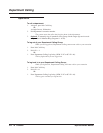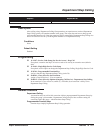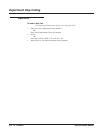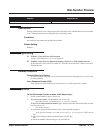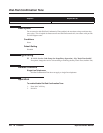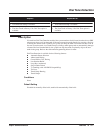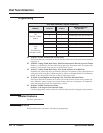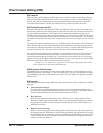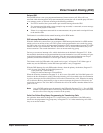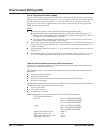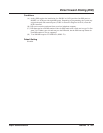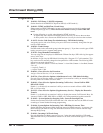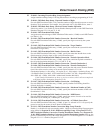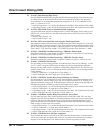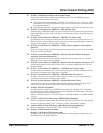
Direct Inward Dialing (DID)
280 ◆ Features Aspire Software Manual
DID Camp-On
DID Camp-On sets what happens to DID calls to busy extensions when you have Busy Intercept
disabled. With DID Camp-On enabled, a call to a busy extension camps-on for the DID Ring No
Answer Time interval. It then diverts to the programmed DID Intercept extension ring group or
Voice Mail. Without DID Camp-On, the caller to the busy extension just hears busy tone.
DID Routing Through the VRS
DID calls can optionally route through the VRS. The DID caller hears an initial Automated Atten-
dant Greeting explaining their dialing options. If the caller mis-dials, they can hear a second greet-
ing with additional instructions. For example, the first Automated Attendant Greeting can be,
“Thank you for calling. Please dial the extension number you wish to reach or dial 0 for the opera-
tor.” If the caller inadvertently dials an extension that doesn’t exist, they could hear, “The extension
you dialed is unavailable. Please dial 0 for assistance or dial # to leave a message so we can call you
back.”
You assign Automated Attendant greetings (i.e., VRS Messages) to the numbers in each Translation
Table. This provides you with extensive flexibility when determining which greetings the system
should play for which dialed numbers. You could, for example, set up 926 5401 through 926 5449
to route to extensions 301- 349, and have 926 5450 route to the automated attendant.
The system allows an extension to be defined as a 1-digit number which can be dialed by the out-
side caller on a DID/DISA trunk using the VRS. The outside caller is able to access to desired
extension/department group by dialing only 1 digit after the system answers the call. If the same
number is used as the first digit of an extension number as well as the 1-digit access code for DID/
DISA, the outside caller will not be able to access the extension.
Example: If ‘2’ is defined as a 1-digit access code to department group 300, outside
callers cannot access extensions 200-299 directly.
SMDR Includes Dialed Number
The SMDR report can optionally print the trunk’s name (entered in system programming) or the
number the incoming caller dialed (i.e., the dialed DID digits). This gives you the option of analyz-
ing the SMDR report based on the number your callers dial. (This option also applies to an ISDN
trunk as well.)
DID Intercept
DID Intercept automatically reroutes DID calls under certain conditions. There are three types of DID
Intercept:
● Vacant Number Intercept
If a caller dials an extension that does not exist or mis-dials, Vacant Number Intercept can
reroute the call to the programmed DID Intercept extension ring group or Voice Mail. Without
Vacant Number Intercept, the caller hears error tone after mis-dialing.
● Busy Intercept
Busy Intercept determines DID routing when a DID caller dials a busy extension. If Busy
Intercept is enabled, the call immediately routes to the programmed DID Intercept extension
ring group or Voice Mail. If Busy Intercept is disabled, the call follows DID Camp-On pro-
gramming (see below).
● Ring-No-Answer Intercept
Ring-No-Answer Intercept sets the routing options for DID calls that ring unanswered at the
destination extension. With Ring-No-Answer Intercept enabled, the unanswered call reroutes
to the DID Intercept extension ring group or Voice Mail after the DID Ring-No-Answer Time
interval. If Ring-No-Answer Intercept is disabled, the unanswered call rings the destination
until the outside caller hangs up.



